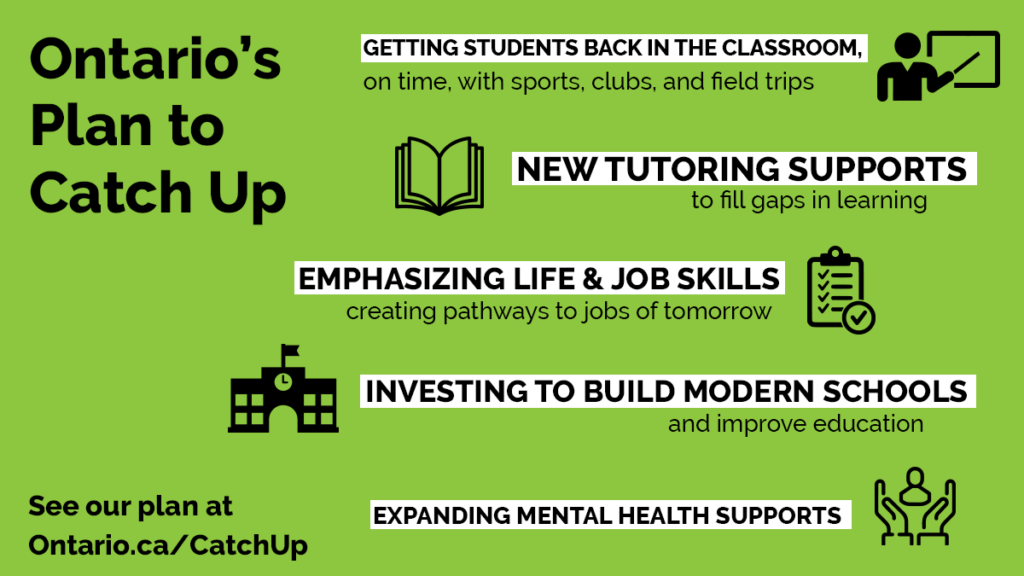ONTARIO LAUNCHES ITS PLAN TO CATCH UP

Plan Starts with Students Back in Classrooms, On Time
News Release
TORONTO — After two years of pandemic disruptions, Ontario today launched its Plan to Catch Up for the 2022-23 school year. The plan, which is supported by the government’s historic investments in education, starts with students back in classrooms, on time, with the full school experience including extracurriculars like clubs, band and field trips.
“Our government is looking ahead as we remain squarely focused on ensuring students receive the best stable learning experience possible, and that starts with them being in class, on time, with all of the experiences students deserve,” said Stephen Lecce, Minister of Education. “We have a plan for students to catch up, including the largest tutoring program in Ontario’s history, a modernized skills-focused curriculum to prepare students for the jobs of tomorrow, and enhanced mental health supports.”
Ontario’s Plan to Catch Up is squarely focused on the priorities of parents and includes five key components:
- Getting kids back in classrooms in September, on time, with a full school experience that includes extra-curriculars like clubs, band, and field trips;
- New tutoring supports to fill gaps in learning;
- Preparing students for the jobs of tomorrow;
- Providing more money to build schools and improve education; and
- Helping students with historic funding for mental health supports.
The full Plan to Catch Up can be found online here.
The government has made key investments that students and educators are already benefiting from, including:
- More than $26.6 billion in funding for the 2022-23 school year, the highest investment in public education in Ontario’s history.
- Investing more than $175 million for enhanced tutoring support programs delivered by school boards and community partners, with a focus on reading, writing and math.
- $304 million in time-limited funding to support the hiring of up to 3,000 front line staff, including teachers, early childhood educators, educational assistants, and other education workers.
- Investing $14 billion to build state-of-the-art schools and classrooms and renew and repair existing schools, including $2.1 billion for the 2022-23 school year.
- Allocating $90 million for mental health initiatives and supports for students, a 420 per cent increase from 2017-18.
- Additional funding to support students with exceptionalities through a $93 million increase in funding for the Special Education Grant and over $9 million in funding to support the new de-streamed grade nine program, with an emphasis on supporting students most at risk including students from racialized, Black, immigrant, and Indigenous communities.
“With almost 50,000 children benefiting from Ontario’s tutoring investments every week, and summer learning programs underway province-wide, Ontario’s plan is getting students back on track,” added Minister Lecce. “With an emphasis on getting back to basics, our government is focused on strengthening life and job skills in the classroom, so that students graduate as financially literate, technologically savvy, emotionally intelligent leaders, ready for the jobs of tomorrow.”
Nationally, Ontario students continue to be among the top performers in math, reading and science, as demonstrated in the 2019 Pan-Canadian Assessment Program results. Ontario’s Plan to Catch Up will help preserve the province’s competitive advantage and ensure students have the skills they need for the jobs of the future as they recover from the impacts of the COVID-19 pandemic.
Quick Facts
- As of the beginning of April 2022, ministry-funded tutoring programs were underway across the province. From May to June 2022, on average, approximately 49,000 students participated in tutoring programs each week, with an average group size of less than five students to provide tailored and focused support.
- With supportive policies and programs delivered by the ministry, school boards and partners, Ontario students have overcome many of the challenges of the pandemic, and graduation rates continue to rise. In 2020-21, 84.2 per cent of the 2016-17 grade nine cohort of students received their high school diploma within four years and 89 per cent of students received their high school diploma within five years.
- Since August 2020, more than $665 million has been allocated to improve ventilation and filtration in schools as part of the province’s efforts to protect against COVID-19. These investments have resulted in improvements to existing ventilation systems; deployment of over 100,000 standalone HEPA filter units and other ventilation devices to schools; upgrades to school ventilation infrastructure; and increased transparency through public posting of school board standardized ventilation measure reports.
- Up to 9,000 HEPA filter units were deployed to child care centres to provide further protection against COVID-19.
- Over the course of the pandemic, child care programs stayed open and served children and their families, including providing emergency child care for front line workers during periods of school closure and remote learning.
Additional Resources